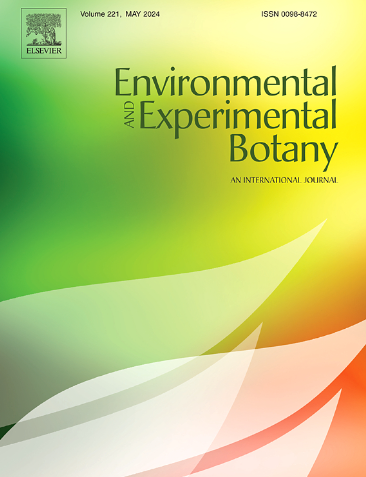利用高光谱表型对干旱胁迫下杨树代谢物谱进行准确、无损的预测
IF 4.7
2区 生物学
Q2 ENVIRONMENTAL SCIENCES
引用次数: 0
摘要
准确预测多年生木本生物能源作物的耐旱性对波动降水条件下生物质的可持续生产至关重要。在可见-近红外(VNIR)和短波红外(SWIR)范围内的高光谱成像(HSI)为预测植物生化性状提供了一种有希望的方法,但其在代谢物分析中的应用仍有待探索。我们将VNIR+SWIR HSI与非靶向代谢组学相结合,研究了8种杨树基因型叶片在干旱诱导下的代谢变化。代谢物分析鉴定了127种化合物,其中73种表现出显著的干旱响应,包括氨基酸(AA)、碳水化合物(CHO)、酚类苷(PG)、有机酸(OA)、脂肪酸和醇类(FA)、萜烯(T)、酚类代谢物(P)和未分类代谢物。光谱分析显示,干旱胁迫下植物在VNIR和SWIR波段的反射率持续升高,AA积累增加,CHO和PG水平降低。最小绝对收缩率和选择操作(LASSO)回归模型确定了代谢物浓度的可靠光谱预测因子,VNIR波长(500-700 nm)主要与AA和P相关,而SWIR波长(1680-1700 nm)可靠地预测CHO, OA和t。几种稳定的光谱-代谢物关联在两种灌溉制度(干旱与充足)中持续存在,突出了它们作为非破坏性胁迫监测的光谱生物标志物的潜力。最小的基因型特异性变异表明,观察到的光谱和代谢反应主要是由环境因素驱动的,可能反映了所研究的商品杨树基因型之间有限的遗传多样性。本研究建立了VNIR+SWIR高光谱成像作为一种强大的、非破坏性的表型分析工具,用于精确监测和有针对性地提高生物能源作物的抗旱性。本文章由计算机程序翻译,如有差异,请以英文原文为准。
Leveraging hyperspectral phenotyping for accurate, non-destructive prediction of metabolite profiles in poplar under drought stress
Accurately predicting drought tolerance in woody perennial bioenergy crops is critical for sustainable biomass production under fluctuating precipitation. Hyperspectral imaging (HSI) in the visible-near-infrared (VNIR) and shortwave-infrared (SWIR) ranges offers a promising approach for predicting plant biochemical traits, yet its application in metabolite profiling remains underexplored. We integrated VNIR+SWIR HSI with untargeted metabolomics to investigate drought-induced metabolic shifts in Populus leaves from eight Populus genotypes. Metabolite profiling identified 127 compounds, with 73 showing significant drought responses spanning amino acids (AA), carbohydrates (CHO), phenolic glycosides (PG), organic acids (OA), fatty acids and alcohols (FA), terpenes (T), phenolic metabolites (P), and unclassified metabolites. Spectral analysis revealed consistently higher reflectance across VNIR and SWIR wavelengths in drought-stressed plants, corresponding with increased accumulation of AA and reduced CHO and PG levels. Least absolute shrinkage and selection operator (LASSO) regression modeling identified robust spectral predictors of metabolite concentrations, associating VNIR wavelengths (500–700 nm) predominantly with AA and P, whereas SWIR wavelengths (1680–1700 nm) reliably predicted CHO, OA, and T. Several stable spectral-metabolite associations persisted across the two watering regimes (drought vs. well-watered), highlighting their potential as spectral biomarkers for non-destructive stress monitoring. Minimal genotype-specific variation suggests that observed spectral and metabolic responses were driven primarily by environmental factors, likely reflecting limited genetic diversity among the commercial Populus genotypes examined. This work establishes VNIR+SWIR hyperspectral imaging as a powerful, non-destructive phenotyping tool for precision monitoring and targeted improvement of drought resilience in bioenergy crops.
求助全文
通过发布文献求助,成功后即可免费获取论文全文。
去求助
来源期刊

Environmental and Experimental Botany
环境科学-环境科学
CiteScore
9.30
自引率
5.30%
发文量
342
审稿时长
26 days
期刊介绍:
Environmental and Experimental Botany (EEB) publishes research papers on the physical, chemical, biological, molecular mechanisms and processes involved in the responses of plants to their environment.
In addition to research papers, the journal includes review articles. Submission is in agreement with the Editors-in-Chief.
The Journal also publishes special issues which are built by invited guest editors and are related to the main themes of EEB.
The areas covered by the Journal include:
(1) Responses of plants to heavy metals and pollutants
(2) Plant/water interactions (salinity, drought, flooding)
(3) Responses of plants to radiations ranging from UV-B to infrared
(4) Plant/atmosphere relations (ozone, CO2 , temperature)
(5) Global change impacts on plant ecophysiology
(6) Biotic interactions involving environmental factors.
 求助内容:
求助内容: 应助结果提醒方式:
应助结果提醒方式:


